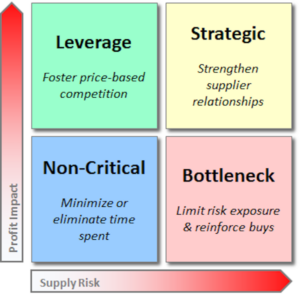Most organizations deal with a large number of suppliers on a daily basis. We’ve examined three different groups of these suppliers throughout this series – check out the links below for any you may have missed:
- Non-Critical Suppliers – Procurement can cut costs if we can avoid wasting time on high-volume, low-spend purchases. These purchases cost more in our time and energy than the price of the buys, themselves.
- Bottleneck Suppliers – Procurement can cut costs by taking back negotiating leverage held by these suppliers (but should more likely attempt to reinforce the supply chain here).
- Leverage Suppliers – Procurement can cut costs by fully leveraging our stronger position at the negotiation table to drive down prices.
Together, these three categories contain the vast majority of our suppliers. The final category is significantly smaller than any of the others – yet is much more important. Today, we’ll review our Strategic Suppliers. These suppliers sit at the upper right-hand corner of our Kraljic matrix (shown below for the last time in this series), the highest point of supply risk and profit impact:

Up to this point, much of the cost-cutting strategies we’ve discussed take place in the short- to medium-term. Impacts to this quadrant, however, can have a lasting impact on our organizations for years to come.
Strategic Supplier Relationships
Suppliers in this quadrants all share some big ticket commonalities:
- First and foremost – the products we buy from these suppliers shape our organizations. The way we conduct business and the final product we offer to our own customers rely on these suppliers.
- There is a natural scarcity in the market. Not many suppliers can deliver these products, and there will likely be significant variation between offerings. Replacing suppliers will not be “plug and play.”
- Relationships here last years, sometimes decades.
Examples here are simple. If you make cars, this is your engine. If you build computers, this is your processor. If you’re Kenny G, these are the smooth, buttery sounds flowing out of that sax and into your local elevator or weather channel playlist.
A huge part of the products we buy from these suppliers is the subject matter expertise held by their teams. As talented as a Procurement team may be, we will not match the insights these suppliers can provide. Instead, we should do what we can to leverage this SME.
Promote Integration with Suppliers
Points of negotiation leverage are much more fluid and balanced here than in other quadrants. Buyers don’t have a lot of options in the market and would have trouble substituting a competing product. Likewise, suppliers often can’t risk losing big ticket customers.
Rather than trying to think in terms of leverage (or a lack thereof), we’ll need to shift focus towards developing a partnership.
- Bring suppliers into company activities. For example, train their personnel on your team’s processes and brainstorm how they could be more supportive of any weaknesses. Where along your workflow could they be better ingrained to build process efficiencies?
- Develop joint partnerships. Your organization is heavily invested in the products these suppliers offer – further investment in joint R&D for product redesign or new service offerings will take an already key product and tailor it to your organization’s specific use while further orienting the supplier to better serve your needs.
Monitor the Relationship
Long-term relationships tend to lose our attention over shorter periods. If a supplier appears to be delivering consistently, why check up on them every month considering they’ve been a supplier for a decade, right?
This is a slow-moving trap that many organizations fall into. Think about the story of the boiling frog. Put a frog in a pot of boiling water and it jumps away – put that same frog in cool water while slowly raising the temperature and it won’t even notice. At the end of the day, issues that build up incrementally grow into big problems that all too often fly under the radar until too late.
- Watch your SLAs and KPIs like a hawk. Now is the perfect time to take a look at your supplier’s obligations and make sure they’re living up to them. If you haven’t developed any KPIs or monitoring processes, start thinking through what measures define success or failure, and how Procurement can go about confirming a supplier stays on track.
- Stay rigid with scheduled check-ins. It is common for quarterly reviews to get pushed back, shortened, or skipped altogether years into these long relationships. Don’t let it happen. Likewise, stick to the agenda even if it feels “done to death” over the years: These meetings are to reconcile today’s performance, not recounting the good years of the past.
Move Beyond the End Point
It is too easy to consider suppliers in terms of their product delivery. In fact, this makes sense for some other quadrants – not so for Strategic suppliers. Procurement should fully consider these critical supplier’s operations.
- Know what their BC/DR strategy is, know what understand their risk level. Your organization likely spend plenty of money making sure operations aren’t interrupted if and when disaster strikes. However, can your supplier say the same? A chain is as strong as the weakest link – and strategic suppliers are a very important link. Review business continuity and disaster recovery plans with suppliers. If your organization is much stronger here, work to have your own resources help guide the supplier in revising policy and procedure.
- Understand where the product you rely on fits within the supplier’s portfolio. Sure, this product is critical for you to buy… but is it just as critical for your supplier to sell? Are they planning to make changes to better serve the market… but to your organization’s detriment? Are they pivoting their business away from your product and towards another entirely? If either ends up being the case, we can help our organizations align our own business to either shift alongside these changes…. Or begin the process of finding a replacement. Given the large influence these products have, however, we can’t do either if we don’t see this change coming.
Bring in the Whole Organization
The key to successfully improving Strategic relationships is bringing the whole organization into the initiative. Procurement, alone, can’t have a big enough impact to move needle. The importance of these relationships, and the wide-reaching impact they have, requires buy-in and commitment from upper management on down to the front line stakeholders who directly work with these products.
As we wrap up this series, I’d like to extend this notion to all four quadrants – “business as usual” can often be a euphemism for complacency. Our organizations may have spent years approaching procurement activities and supplier relationships in the same tried-and-true way. Trying to move from autopilot to thoughtful, deliberate decision-making will be met with resistance. Why? Because we’re asking for more time spent and more attention paid to something that stakeholders don’t even see as an issue.
Yet this is what Procurement must do. This is a monumental task during the good years when business hums along – however, this year is not shaping up to be one of those years. If we can take just a small silver lining from everything happening in the world, perhaps it is that Procurement has a direct example of just how much uncertainty we face – and how we can work to address it.
This blog originally appeared on the Strategic Sourceror
























